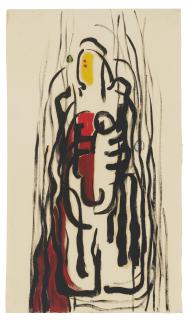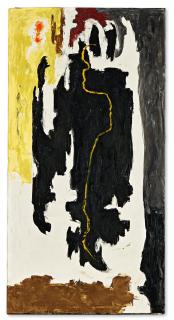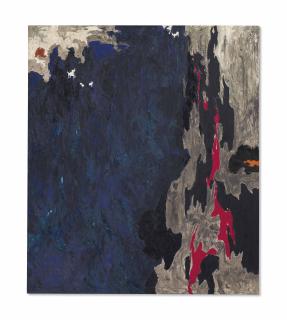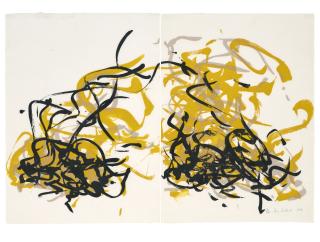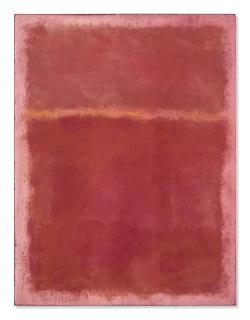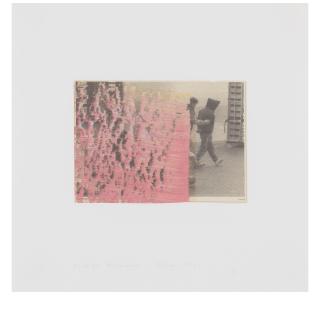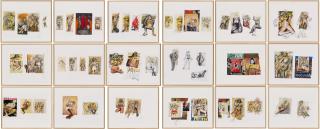Clyfford Still 1904 - 1980
The artist Clyfford Still
- US American painter associated with abstract expressionism.
- Also associated with the Colour Field Movement.
- Among Still's best-known paintings is 1957-D No. 1 (1957).
Born in Grandin, North Dakota, on 30 November 1904, the US painter Clyfford Still is associated with abstract expressionism and the colour field movement. After graduating from Spokane University in 1933, he went to Washington State College, where he received his master's degree in fine arts in 1935 and taught painting, art history and aesthetics until 1941. From 1943 to 1945 he taught in Richmond, Virginia, before moving to New York in 1945. Here he became friends with Jackson Pollock and Mark Rothko and exhibited with both of them as well as with Barnett Newman. At this time Still began to title most of his works, which he now painted in an abstract expressionist style, with dates and numbers. His solo exhibition at Peggy Guggenheim's Art of This Century gallery in New York gave him his breakthrough in 1946.
In the early 1950s, he moved back to New York for several years, became increasingly isolated and began to restrict the distribution and exhibition of his paintings. The artistic outsider Still refused to exhibit his works, and he reduced the sale of his paintings to a minimum. In 1966, Still and his second wife moved to Windsor, Maryland where he lived until his death on 23 June 1980 in Baltimore.
Today, his art can be found in the Museum of Modern Art (New York), the Art Institute of Chicago, the National Gallery of Art (Washington, D.C.) and, most notably, the Clyfford Still Museum, which opened in Denver in 2011. Four paintings from the estate of his second wife, Patricia Still, were sold at a controversial auction at Sotheby's in November 2011 to fund the museum named after him. The auction raised $114 million for the city of Denver. To this day, the museum manages the entire estate of Clyfford Still.
Clyfford Still is one of the leading figures of the first generation of Abstract Expressionists, who developed a new, powerful approach to painting after the Second World War, and began making paintings with an abstract character as early as the mid-1930s. He is also considered one of the most important colour field painters - his non-figurative paintings are mainly concerned with the juxtaposition of different colours and surfaces. For his paintings he used a thick impasto, which produces a subtle variety and shades that shimmer across the painting surfaces. His large works are reminiscent of natural forms and natural phenomena. Among his most famous paintings is 1957-D No. 1 (1957), which is mainly black and yellow with white spots and also contains a small amount of red.
Der Künstler Clyfford Still
- US-amerikanischer Maler, der dem abstrakten Expressionismus zugeordnet wird.
- Wird auch mit der Farbfeldbewegung in Verbindung gebracht.
- Zu den bekanntesten Gemälden von Still gehört 1957-D No. 1 (1957).
Der am 30.11.1904 in Grandin (North Dakota) geborene US-amerikanische Maler Clyfford Still wird dem abstrakten Expressionismus zugeordnet und mit der Farbfeldbewegung in Verbindung gebracht. Nach seinem Studienabschluss an der Universität von Spokane 1933 ging er an das Washington State College, wo er 1935 seinen Masterabschluss in Bildender Kunst erhielt und bis 1941 Malerei, Kunstgeschichte und Ästhetik unterrichtete. Von 1943 bis 1945 lehrte er in Richmond (Virginia) bevor er 1945 nach New York ging. Hier befreundete er sich mit Jackson Pollock und Mark Rothko und stellte sowohl mit ihnen als auch mit Barnett Newman aus. Zu dieser Zeit begann Still damit die meisten seiner Werke, die er jetzt im abstrakt expressionistischen Stil malte, mit Daten und Nummern betiteln. Seine Einzelausstellung in der New Yorker Galerie Art of This Century von Peggy Guggenheim verschaffte ihm 1946 den Durchbruch.
Anfang der 1950er zog er für mehrere Jahre zurück nach New York, isolierte sich zunehmend und begann, den Verleih und die Ausstellung seiner Gemälde einzuschränken. Der künstlerische Außenseiter weigerte sich geradezu, seine Werke auszustellen, den Verkauf seiner Gemälde reduzierte er auf ein Minimum. 1966 zogen Still und seine zweite Ehefrau nach Windsor, Maryland wo er bis zu seinem Tod am 23.06.1980 in Baltimore lebte.
Seine Kunst ist heute im Museum of Modern Art (New York), im Art Institute of Chicago, in der National Gallery of Art (Washington, D.C.) und vor allem im 2011 in Denver eröffnetem Clyfford Still Museum zu finden. Aus dem Nachlass seiner zweiten Frau, Patricia Still, wurden auf einer umstrittenen Auktion bei Sotheby’s im November 2011 vier Bilder versteigert, um das nach ihm benannte Museum zu finanzieren. Die Auktion brachte der Stadt Denver einen Ertrag von 114 Millionen US-Dollar. Bis heute verwaltet das Museum den gesamten Nachlass von Clyfford Still.
Clyfford Still zählt zu den führenden Persönlichkeiten der ersten Generation der Abstrakten Expressionisten, die nach dem Zweiten Weltkrieg einen neuen, kraftvollen Ansatz in der Malerei entwickelten, und fing bereits Mitte der 1930er damit an, Gemälde mit abstraktem Charakter zu malen. Zudem gilt er als einer der bedeutendsten Farbfeldmaler - seine nicht-figurativen Gemälde beschäftigen sich hauptsächlich mit der Gegenüberstellung verschiedener Farben und Oberflächen. Für seine Gemälde verwendete er ein dickes Impasto, das eine subtile Vielfalt und Schattierungen hervorruft, die über die Malflächen schimmern. Seine großen Werke erinnern an natürliche Formen und Naturphänomene. Zu seinen berühmtesten Gemälden zählt 1957-D No. 1 (1957), das hauptsächlich schwarz-gelb mit weißen Flecken ist und außerdem einem kleinen Rotanteil enthält.
Clyfford Still in a nutshell
Clyfford Still's art is special for many reasons, but perhaps the most notable is his unique style, which was highly influential in the development of Abstract Expressionism. His paintings are characterized by large, jagged fields of color, often divided by sharp vertical lines. They have a raw, almost primal quality that seems to express the intense emotions and energies of the human psyche. One of the things that sets Still's art apart is his focus on pure form and color. He believed that art should be a direct expression of the artist's innermost feelings, and that the forms and colors used should be chosen solely for their expressive power. This led him to reject traditional representational art in favor of a more abstract, expressionist style.
Another reason that Still's art is so special is his deep connection to nature and the natural world. His use of jagged, organic forms and earthy colors reflects his fascination with the landscape of his native western United States. His paintings often evoke the rugged terrain and vast skies of the American West, and are imbued with a sense of the sublime. Finally, Still's art is distinguished by his uncompromising commitment to artistic integrity. He refused to compromise his artistic vision for the sake of commercial success or critical acclaim, and famously withdrew from the art world in the 1950s to preserve the integrity of his work. His dedication to his art and refusal to compromise his principles make him an inspiration to artists and art lovers around the world.
The Clyfford Still Museum is located on Bannock Street in Denver, Colorado. It is located near the Denver Art Museum. Still could barely sell a painting during his lifetime and bequeathed his work to the city, which would dedicate a museum to him. Denver now owns about 93 percent of Still's works and displays them in changing exhibitions.
The city of Denver auctioned off four works from Patricia Still's estate at Sotheby's that fetched a combined price of $114 million. The most expensive work was PH 89 (1949-A.No.1) from 1949, which cost $61.7 million. This money, whose acquisition was not without controversy, was used to finance the museum, which opened in November 2011.
The artist was from the village of Grandin, North Dakota, population 200, where he was born in 1904. Growing up in a rural environment in the rugged north near Canada had a great influence on his approach to life and also to art. His art is primarily characterized by organic, primal forms. He lived in New York, San Francisco and finally, from 1961, in seclusion in Maryland. He died in New York in 1980.
Yes, Still participated in documenta II in 1959. This is unusual, since he lived and worked in increasing isolation from 1952 onward, refusing any public presentation of his work. From 1961 he withdrew definitively from the art world.
Häufige Fragen zu Clyfford Still
Die Kunst von Clyfford Still ist aus vielen Gründen etwas Besonderes, aber der vielleicht bemerkenswerteste ist sein einzigartiger Stil, der für die Entwicklung des Abstrakten Expressionismus sehr einflussreich war. Seine Gemälde zeichnen sich durch große, zerklüftete Farbfelder aus, die oft durch scharfe vertikale Linien unterteilt sind. Sie haben eine rohe, fast ursprüngliche Qualität, die die intensiven Gefühle und Energien der menschlichen Psyche auszudrücken scheint. Still zeichnet sich unter anderem dadurch aus, dass er sich auf die reine Form und Farbe konzentriert. Er war der Ansicht, dass Kunst ein direkter Ausdruck der innersten Gefühle des Künstlers sein sollte und dass die verwendeten Formen und Farben ausschließlich aufgrund ihrer Ausdruckskraft gewählt werden sollten. Dies führte dazu, dass er die traditionelle gegenständliche Kunst zugunsten eines abstrakteren, expressionistischen Stils ablehnte.
Ein weiterer Grund, warum Stills Kunst so besonders ist, ist seine tiefe Verbundenheit mit der Natur. Seine Verwendung von zerklüfteten, organischen Formen und erdigen Farben spiegelt seine Faszination für die Landschaft seiner Heimat im Westen der Vereinigten Staaten wider. Seine Gemälde erinnern oft an das zerklüftete Terrain und den weiten Himmel des amerikanischen Westens und sind von einem Gefühl des Erhabenen durchdrungen. Schließlich zeichnet sich Stills Kunst durch sein kompromissloses Engagement für künstlerische Integrität aus. Er weigerte sich, seine künstlerische Vision um des kommerziellen Erfolgs oder der Anerkennung durch die Kritik willen aufzugeben, und zog sich in den 1950er Jahren aus der Kunstwelt zurück, um die Integrität seines Werks zu wahren. Seine Hingabe an seine Kunst und seine Weigerung, Kompromisse bei seinen Prinzipien einzugehen, machen ihn zu einer Inspiration für Künstler und Kunstliebhaber auf der ganzen Welt.
Das Clyfford Still Museum befindet sich in der Bannock Street in Denver, Colorado. Es liegt in der Nähe des Denver Art Museum. Still konnte zu Lebzeiten kaum ein Bild verkaufen und vermachte sein Werk der Stadt, die ihm ein Museum widmen sollte. Denver besitzt heute rund 93 Prozent aller Still-Werke und zeigt sie in wechselnden Ausstellungen.
Die Stadt Denver versteigerte bei Sotheby’s vier Werke aus dem Nachlass von Patricia Still, die zusammen einen Preis von 114 Millionen Dollar erzielten. Das teuerste Werk war PH 89 (1949-A.No.1) von 1949, das 61,7 Millionen Dollar kostete. Mit diesem Geld, dessen Erwerb nicht unumstritten war, wurde das Museum finanziert, das im November 2011 eröffnet wurde.
Der Künstler stammt aus dem 200-Seelen-Dorf Grandin in North Dakota, wo er 1904 geboren wurde. Das Aufwachsen in einer ländlichen Umgebung im rauen Norden in der Nähe Kanadas hatte großen Einfluss auf seine Einstellung zum Leben und auch zur Kunst. Seine Kunst ist vor allem von organischen, ursprünglichen Formen geprägt. Er lebte in New York, San Francisco und schließlich ab 1961 zurückgezogen in Maryland. Er starb 1980 in New York.
Ja, Still nahm 1959 an der documenta II teil. Das ist ungewöhnlich, da er seit 1952 zunehmend isoliert lebte und arbeitete und jede öffentliche Präsentation seiner Arbeiten ablehnte. Ab 1961 zog er sich endgültig aus dem Kunstbetrieb zurück.

